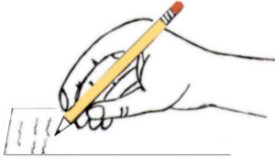Tips for Legible Penmanship
by Elaine Ernst Schneider
Not long ago, a dedicated home educator asked me for any suggestions that I might have for a grandson who was experiencing writing difficulties. Here are the strategies that I suggested. Perhaps they may be of help to someone else.
First, check to see how your student is holding his pencil. If he is holding it incorrectly, he may be straining physically to manipulate the pencil and write. I have worked with children who have done this and a great deal of their manipulation is in the wrist, not giving them much control.
The pencil should be controlled by the fingertips. Look to see if the thumb is actually on the pencil or is wrapped . The tip of the thumb should be near the bottom of the pencil so that it can contribute control of the pencil, not wrapped across the pencil. The index finger and thumb should be on the top of the pencil with the weight of the pencil actually resting on the second finger which is underneath the pencil. I know this sounds crazy, but I have seen DRAMATIC changes in writing when the position of the pencil was changed.

Also try letting the pupil write on a piece of paper that is taped to the wall. Sometimes this will foster a “lighter” touch instead of writing that is obviously produced by “bearing down” hard, pencil to paper on a table or desk.
As for the spacing between words, try this: write several lines on a piece of paper, leaving a line underneath where he can try to write to match your writing – both in neatness AND in the spacing between words. I am working with a girl who does what you describe, running the words together. This method has really helped her. She didn’t have a visual picture of how much space should be left between words. She is doing better now that she has literally seen the spacing I put between words – it’s not the same in a textbook as it is actually writing what she will have to write on notebook paper. Create your own exercises on notebook paper so that he is matching your writing on notebook paper to his writing on notebook paper, word for word, space for space.
Lastly, don’t worry about printing instead of writing cursive. Years ago, we were all taught that by high school, we should write in cursive. But as teachers’ class sizes increased, teachers became more interested in being able to read the many papers given them to read. If printing is the most legible, then that is what teachers nowadays prefer. That is also how it will be in the real world of careers and jobs. People want whatever is easiest to read. You might wonder if your standards and concerns over legibility are too extreme compared to the student’s own. This is typical of kids. Try to find some way to reward him for completing the pages you write and ask him to copy – if it’s a trip to the ice cream parlor or staying up 30 minutes later at night, work out some way to reward a handwriting assignment that is good work and shows effort on the student’s part. Don’t give out the reward too easily – make sure he was worked for it.
I will also say this – I have seen handwriting improve when little boys discover girls. Junior high boys all of the sudden become more concerned with handwriting ( and spelling too!) when they are about to write the proverbial “note” to a girl. Don’t despair. Keep at it and eventually, something will “click” – whether it’s ice cream or the cute girl who serves it !
Ah, yes, that leads me to one other suggestion. I tutor kids and every now and then have a young boy who is just not interested in improving…. but I have a teenage daughter. I get her to step in just long enough to say, “Oh, my, I love that handwriting. Girls like that, you know.” Think of someone young and attractive who might support you with just an occasional encouragement to your child. As much as we love our kids and grandkids, we are still the “establishment.” Team up with a young person who can help with a little positive peer reinforcement. You’d be surprised what a pretty smile can do for innovation!
